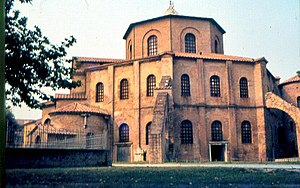
Back بابوية بيزنطية Arabic Papat bizantí Catalan Βυζαντινός παπισμός Greek Papado bizantino Spanish پاپ بیزانس Persian Papauté byzantine French Kepausan Bizantin ID Papato bizantino Italian Det bysantinske pavedømme NB Papautat bizantina Occitan
This article relies largely or entirely on a single source. (April 2014) |

The Byzantine Papacy was a period of Byzantine domination of the Roman Papacy from 537 to 752, when popes required the approval of the Byzantine Emperor for their episcopal consecration, and many popes were chosen from the apocrisiarii (liaisons from the pope to the emperor) or the inhabitants of Byzantine-ruled Greece, Syria, or Sicily. Justinian I reconquered the Italian peninsula in the Gothic War (535–554) and appointed the next three popes, a practice that would be continued by his successors and later be delegated to the Exarchate of Ravenna.
With the exception of Martin I, no pope during this period questioned the authority of the Byzantine monarch to confirm the election of the bishop of Rome before consecration could occur; however, theological conflicts were common between pope and emperor in the areas such as monothelitism and iconoclasm.
Greek-speakers from Greece, Syria, and Sicily replaced members of the powerful Roman nobles in the papal chair during this period. Rome under the Greek popes constituted a "melting pot" of Western and Eastern Christian traditions, reflected in art as well as liturgy.[1]
- ^ Duffy (1997), p. 68.